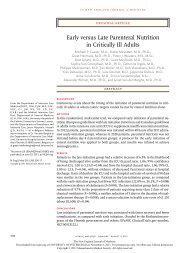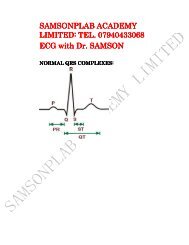ACLS Review
You also want an ePaper? Increase the reach of your titles
YUMPU automatically turns print PDFs into web optimized ePapers that Google loves.
34 <strong>ACLS</strong> (Advanced Cardiac Life Support) <strong>Review</strong> ...<br />
❍<br />
A patient presents pulseless and unresponsive with the following strip. CPR and bag-mask ventilation is in<br />
progress and IV access has been obtained. What is the condition and what is the treatment?<br />
Pulseless electrical activity. Continue CPR, intubate, and give epinephrine 1 mg IVP now and every 3–5 minutes.<br />
(The rhythm strip, although it looks like sinus rhythm is pulseless electrical activity in a pulseless, unresponsive<br />
patient.)<br />
❍<br />
❍<br />
❍<br />
Contrast type I second-degree AV block, or Mobitz type I, from third-degree AV block.<br />
In type I second-degree AV block, the atrial rhythm is regular, the ventricular rhythm is irregular, and the P–R<br />
interval lengthens until a P wave appears with no QRS complex. In third-degree AV block, the atrial and<br />
ventricular rhythms are regular and there is no P–R interval since the atria and ventricles beat independently of<br />
each other. Furthermore, the atrial rate is approximately twice the ventricular rate.<br />
What are alternative names for type I second-degree AV block?<br />
Mobitz type I or Wenckebach.<br />
What is the following rhythm?<br />
Sinus bradycardia. Key features include<br />
a rate of less than 60 beats per minute;<br />
atrial and ventricular rhythms are regular;<br />
P waves are uniform and upright with one P wave before each QRS complex;<br />
P–R interval is 0.12–0.20 seconds;<br />
QRS is usually 0.10 seconds or less.







